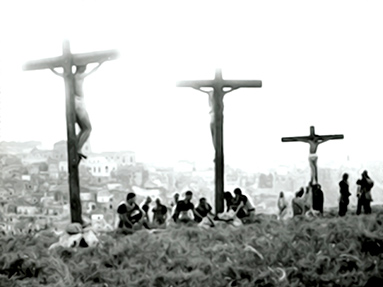Below, find an introduction by the poet Eileen Myles to St. Paul (A Screenplay) by Pier Paolo Pasolini. In July, Verso Books published a new translation by Elizabeth A. Castelli, and graciously let us excerpt the following passages.
There was such a crowd on that Saturday night in early August when Light Industry (so much more than a screening room), one of the live spaces in town that argues well for New York still qualifying as a vital art city, hosted a reading of the spanking new St. Paul (a screenplay) just out from Verso. Pasolini, dead since 1975 when he was murdered in Ostia, a beach suburb of Rome, still can draw a crowd at the drop of a hat; a list of notables respectfully peeled themselves off the beach or from their sticky desks, adding heft to the event. Lynne Tillman, and Hilton Als, Paul Chan and Ariana Reines, Martha Rosler, the translator, Elizabeth Castelli and even my own humble self all read aloud from the hot pink book in hand.
Pasolini intrigues us. Why? He did everything, and well, and he died before he got old. I’d never read a screenplay of Pasolini’s before. It is so breathtaking to watch as he proposes a film that is a mix of World War II era archival footage alongside, as he puts it, the “fictional” characters of St. Paul and the apostles. Line by line, Pasolini is both poet and precise and sneering Marxist: He describes the servants in one scene as being “subproletariat….of the triumphalist bourgeoisie.” Don’t we long to hear that exact awkward kind of attribution in public life today?
St. Paul, the book, is a dream of a film, and Paul is an alter ego of Pasolini’s - just as Pasolini, collectively, works like that for a lot of us. As an embittered and lapsed Catholic (and communist), Pasolini’s impulse to erect an equivalent of St. Paul moving through modern-day London, Geneva, Paris, and even New York has less to do with Pasolini’s interest in Paul’s famed experience on the road to Damascus and more with revealing Paul converting all over again from saint to priest. It was like thinking about Warhol after he was shot. Paul's, and Pasolini’s, is a postmodern dilemma. Pasolini’s complex path included his being a queer political youth whose younger brother was shot by a rival communist faction during the war. Pasolini found no safe home ever (or wanted it) in the fanatical fascist regime, the corrupt post-war bureaucracy, Marxist ideology, and so, like Paul who ultimately brought Christianity to its institutional present, Pasolini wrangled his own pile of irreconcilables again and again into the edifice of film.
Though reading Pasolini’s St. Paul one kind of longs for the right filmmaker to step up and realize its vision, the perfection of its unmadeness sits perfect today with the winds of all temporality reading and breathing by our sides.
